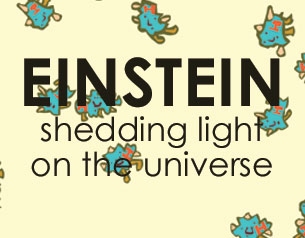Einstein- Shedding Light on the Universe
This lively and informative offers a fun way of learning about Einstein's life and theories.
 Einstein's theories revolutionised our world, giving birth to a new nuclear age. His name has become a byword for intelligence; his iconic image adorns countless posters. This lively and informative educational film made for a teenaged audience offers a fun way of learning about Einstein's life and theories. Using dynamic and colourful animation we are introduced to the ideas behind relativity and nuclear physics. We also get to know a bit more about the man behind the crazy white hair...
Einstein's theories revolutionised our world, giving birth to a new nuclear age. His name has become a byword for intelligence; his iconic image adorns countless posters. This lively and informative educational film made for a teenaged audience offers a fun way of learning about Einstein's life and theories. Using dynamic and colourful animation we are introduced to the ideas behind relativity and nuclear physics. We also get to know a bit more about the man behind the crazy white hair...
Einstein spent the early part of his career struggling in obscurity. His parents wanted him to take over the family store but Albert had other plans. Even as a teenager, he had his sites set on studying physics. "If I cannot study what I am interested in, then life is not worth living!" he fumed. At 17, he left home for good to enter the Swiss institute of Technology.
At University, Einstein conducted his own experiments into the behaviour of light. His work challenged the accepted theory that light travelled through an 'ether', proving that the speed of light was constant. Animated explanations chart the process of his investigations.
But his professors resented his independent streak and crazy ideas and refused to give him a good reference.
Tough times ensue until an early civil service job enabled him to marry fellow student Mileva Maric. They had two sons. He began work on his theories of relativity after being inspired by the train journey home. "In a flash it all became clear to me. The change of time in relative motion was the key that unlocked the puzzle of the constant speed of light." This new perspective on space and time was a turning point in Einstein's career. It led to the development of the special theory of relativity. Finally, after years of struggle, his career was about to take off. But when he was offered the prestigious directorship of the Institute for Physics in Berlin it spelt the end of his marriage. Worried their sons would be drafted into the German army, Mileva refused to relocate. Alone and unhappy in Berlin, Einstein threw himself into his work. Over the next several years, he expanded his theories, working towards a deeper understanding on how gravitational force relates to time and space. His ground-breaking discoveries culminated in the Special Theory of Relativity: E = MC². Lively cartoons take us step by step through this equation, explaining how the work of past scientists like Newton and Maxwell contributed to this theory. By the 1930s Einstein had become an international figure. But the rise of the Nazis alienated him and he fled to America. As he later commented: "Nationalism is an infantile disease. It is the measles of mankind." He would remain a "militant pacifist" all his life. But worried about the prospect of a Nazi victory, he wrote to Rooselvelt urging the development of the atomic bomb. It was a decision he came to bitterly regret. Today, Einstein's legacy goes far beyond the laboratory. He has come to represent not only scientific genius but also the spirit of creativity and freedom of expression.
FULL SYNOPSIS
Tough times ensue until an early civil service job enabled him to marry fellow student Mileva Maric. They had two sons. He began work on his theories of relativity after being inspired by the train journey home. "In a flash it all became clear to me. The change of time in relative motion was the key that unlocked the puzzle of the constant speed of light." This new perspective on space and time was a turning point in Einstein's career. It led to the development of the special theory of relativity. Finally, after years of struggle, his career was about to take off. But when he was offered the prestigious directorship of the Institute for Physics in Berlin it spelt the end of his marriage. Worried their sons would be drafted into the German army, Mileva refused to relocate. Alone and unhappy in Berlin, Einstein threw himself into his work. Over the next several years, he expanded his theories, working towards a deeper understanding on how gravitational force relates to time and space. His ground-breaking discoveries culminated in the Special Theory of Relativity: E = MC². Lively cartoons take us step by step through this equation, explaining how the work of past scientists like Newton and Maxwell contributed to this theory. By the 1930s Einstein had become an international figure. But the rise of the Nazis alienated him and he fled to America. As he later commented: "Nationalism is an infantile disease. It is the measles of mankind." He would remain a "militant pacifist" all his life. But worried about the prospect of a Nazi victory, he wrote to Rooselvelt urging the development of the atomic bomb. It was a decision he came to bitterly regret. Today, Einstein's legacy goes far beyond the laboratory. He has come to represent not only scientific genius but also the spirit of creativity and freedom of expression.
